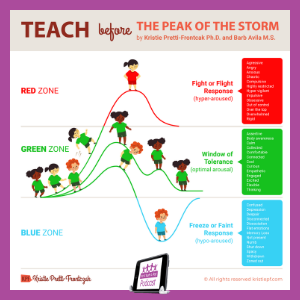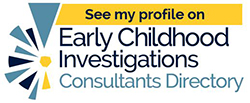 “I have two different jobs. I’m either in the Green Zone with the child and I’m helping them learn self-regulation skills; or in the moment they move into the red or the blue zones, I’m helping them to process, I’m co-regulating, and I’m offering a lifeline.”
“I have two different jobs. I’m either in the Green Zone with the child and I’m helping them learn self-regulation skills; or in the moment they move into the red or the blue zones, I’m helping them to process, I’m co-regulating, and I’m offering a lifeline.”
Part 1: Clarification when it comes to inclusion for ALL
In this part of the episode, I share why our primary job is to extend the green zone for optimal learning, even when it comes to placement decisions for children who qualify for early childhood special education.
It will be a bit of an eye opener/conversation starter for those who think we’re soothing the nervous system by placing a child in a more restrictive environment. In other words, while a “self-contained” classroom might “look better” or to us might even feel a little bit better (or safer might be the word), we’re actually promoting rigidity, which is also outside the zone of optimal learning.
Part 2: Our Two Jobs
In the second part of the podcast I explore the two jobs teachers have…the one when children are in the green zone and then one when they aren’t.
If they’re in the Green Zone, our job is really to keep them there and to notice, recognize, and identify when they might be leaving that Green Zone. Our job is to also help children learn how to stop, think, and then act…to become self-aware of their emotions and how to help keep themselves in the green zone.
When children are in the red or blue zone, our job shifts to offering a lifeline to a child- helping them to be curious about us and allowing for processing of big emotions.
Show Notes (related resources)
- Dr. Shauna Tominey’s Resources
- Creating Compassionate Kids – Book, blog, and much, much more
- Stop, Think, Act – Book with hands-on activities to help children learn self-regulation techniques
- Dr. Barb O’Neill’s Resources
- Challenging behavior: What if you’re caught in a no win trap? – Blog about shifting from compliance to focusing on co-regulation and setting compassionate limits
- How to help kids express their emotions and needs rather than use aggression – Free tip sheet with strategies to help children express their emotions, needs and desires
- How to effectively teach social-emotional skills to children who exhibit challenging behavior – Webinar on why playful learning is central to the social-emotional development of children
- Dr. Mona Delahooke’s Resources
- Why we misunderstand traumatized children’s behavioral challenges and how we can do better – How to recognize that not all misbehavior is intentional
- Beyond behaviors: Using brain science and compassion to understand and solve children’s behavioral challenges – Book contains worksheets and charts for reducing behavioral challenges and promoting resilience
- Seed & Sew Resources
- Seed & Sew’s Tiny Humans, Big Emotions Series – Tools for supporting children’s coping strategies, self-awareness, and identification of feelings, as well as networking with other caregivers
- Episode 79- Co-reg vs. Self-reg with Thriving Littles – Podcast on why we need to co-regulate to help children develop effective self-regulation skills
- Synergy Autism Center’s Resources
- Episode #19: Regulation is Required for Curiosity to Thrive Download – 10 strategies for reducing stressors for children with autism
- Dr. Kristie Pretti-Frontczak’s Resources
- The red train has left the station! – How to tell the difference between “typical reactions” and when a child is flooded with emotion and needs help off the red train
- Reducing children’s exposure to stress one zig-zag at a time – The seven developmental progressions of the “zigzag process” to reduce stressors
- Extending the Green Zone of Optimal Learning from the Teaching with the Brain in Mind pre-conference session – Portion of a session Dr. Kristie Pretti-Frontczak and Laura Fish delivered at the 2018 Division for Early Childhood Conference
- 5 steps to magically teach self-regulation – How to teach self-regulation to young children
- A brain architect’s guide for reducing ECE stressors – Infographic with strategies for getting out of the red or blue zones
- Pre-K Teach and Play Practice Point- Early childhood stressors – Alphabetical list of classroom-based stressors
- Reducing stressors and extending the green zone for adults [blog]
- Tips for triggering the positive emotional attractor [blog]
- Misc. Resources
- The river of integration: Discovering flow and harmony between the chaos and rigidity – Blog on how the river represents a “calm” child and river bank represent a child who is feeling chaotic or rigid
- The Zones of Regulation – A framework for fostering self-regulation and emotional control
- Window of Tolerance – What “window of tolerance” and the “green zone” are all about
- Kansas Inservice Training Center (KITS) Consultation Corner in the June 2017 issue on authentically exploring children’s play – Guidelines to identify the difference between a want and a need
- A few of my favorites from Laura Fish
